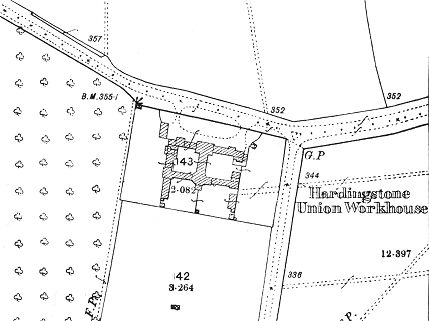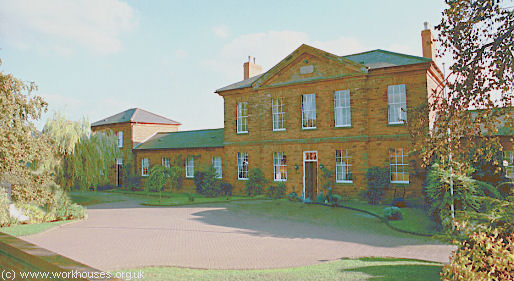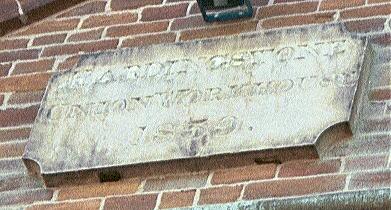Hardingstone, Northamptonshire
Up to 1834
A parliamentary report of 1777 recorded parish workhouses in operation at Hardingstone (for up to 16 inmates) and Yardley Hastings (25 inmates). The latter establishment dated from at least 1725.
After 1834
The Hardingstone Poor Law Union formally came into being on 20th July 1835. Its operation was overseen by an elected Board of Guardians, 22 in number, representing its 20 constituent parishes as listed below (figures in brackets indicate numbers of Guardians if more than one):
County of Northampton:
Brafield on the Green, Castle Ashby cum Chaddeston, Coghennoe or Cooknoe [Cogenhoe], Collingtree, Courteenhall, Denton, Hackleton, Hardingstone (2), Horton, Great Houghton, Little Houghton, Milton or Middleton Malzor, Piddington, Preston Deanery, Quinton, Road or Rode [Roade], Rotherstone, Whiston, Wootton, Yardley Hastings (2).
Later Additions: Far Cotton (from 1895).
The population falling within the (original) Union at the 1831 census had been 5,954 — with parishes ranging in size from Furtho (population 16) to Paulerspury (1,092). The average annual poor-rate expenditure for the period 1833-5 had been £5,375 or 18s.1d. per head of the population.
After a lengthy period of wrangling, the Guardians was eventually decided to set up a new workhouse at a site to the south of Hardingstone village on the south side of the Newport Pagnell Road. Designed by a Mr Milne, it was built in 1838-39 at a cost of around £3,750. It could accommodate 130 and admitted its first inmates on 25th May 1840. The main workhouse building had a broadly cruciform layout, as can be seen on the 1887 map below.

Hardingstone site, 1887.
The Hardingstone building seems to have had limited provision for providing work for its inmates amongst whom were unemployed lace workers. Some work was provided at the old Wootton workhouse site, with Hardingstone providing residential accommodation. This included a day nursery where unmarried mothers left their children while they went off to work.

Hardingstone workhouse from the north, 2000.
© Peter Higginbotham.

Hardingstone workhouse, 2000.
© Peter Higginbotham.
The workhouse closed in 1925 by which time passing vagrant "casuals" formed the main clientele of the workhouse. The then master, a Mr Crompton, continued for a while to find work for the vagrants in the form cutting wood and pumping water. In 1928, the the county council began renting rooms in the workhouse for use as a temporary school, with the yards used as playgrounds.
The site was later used as a county council depot. Much of the southern parts of the building have been demolished. The main range to the north has now been converted into private residences.
Staff
Inmates
Records
Note: many repositories impose a closure period of up to 100 years for records identifying individuals. Before travelling a long distance, always check that the records you want to consult will be available.
- Northamptonshire Record Office, Wootton Hall Park, Northampton, Northants, NN4 8BQ. A wide variety of records survive including: Guardians' minutes (1835-1914); Admissions and discharges (1901-25); Births (1837-97, 1915-22); Deaths (1836-1925, with gaps); Creed register (1900-15); etc.
Bibliography
- Higginbotham, Peter The Workhouse Encyclopedia (2014, The History Press)
Links
- None.
Unless otherwise indicated, this page () is copyright Peter Higginbotham. Contents may not be reproduced without permission.


